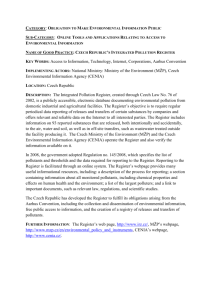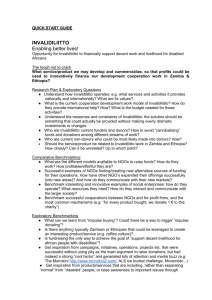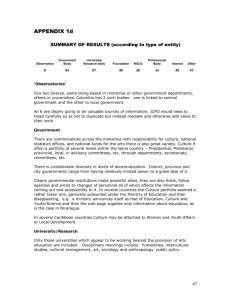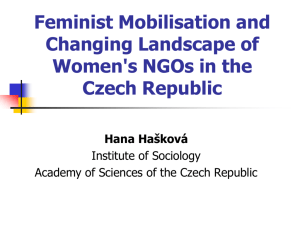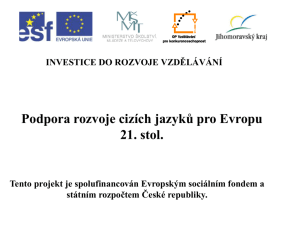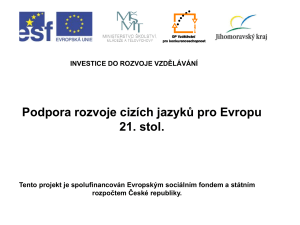Landscape as a place for human
advertisement
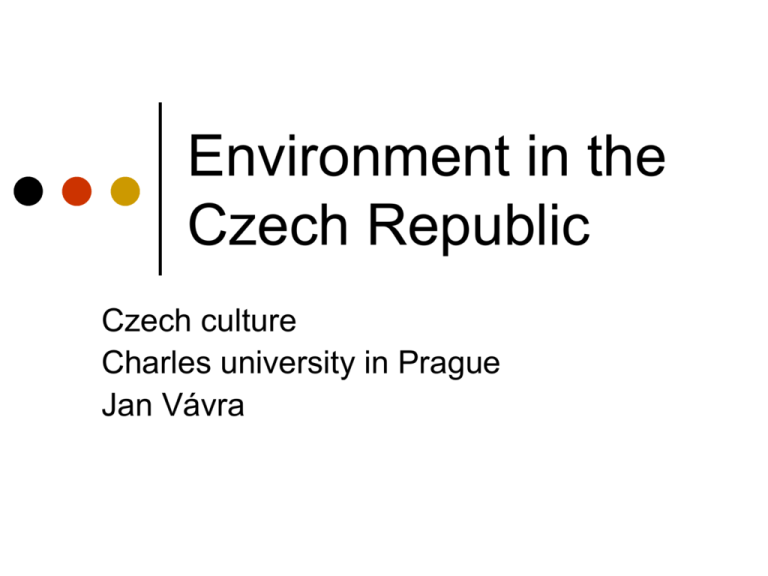
Environment in the Czech Republic Czech culture Charles university in Prague Jan Vávra Lecture outline Environmental problems Agriculture Car transportation Brown coal mining and burning Air pollution Environmental politics and NGOs Intensive agriculture soil too much compact fast runoff of precipitation - floods soil erosion 50 % of arable land is in risk of water erosion extreme use of fertilizers usually nitrogenous and phosphorus affecting mostly watersheds more than 10 % of environmentally friendly agricultural land (meadows, not arable land) Changes 1953-2008 http://kontaminace.cenia.cz Car transportation air pollution mostly CO2, CO, NOx emissions VOC, PM, SO2 as well Pb almost disappeared landscape occupation and fragmentation CO2 emissions 1990-2007 EC (2010) Passengerkilometers/person/year in 2009 Zpráva o životním prostředí ČR 2010. Landscape fragmentation (2005) Příroda a krajina České republiky. Zpráva o stavu 2009 Landscape fragmentation 1980 (81 % UAT) UAT = Unfragmented Area by Traffic > 100 km2 < 1000 cars/day Příroda a krajina České republiky. Zpráva o stavu 2009 Landscape fragmentation 2005 (64 % UAT) Příroda a krajina České republiky. Zpráva o stavu 2009 Landscape fragmentation 2040 (53 % UAT) Příroda a krajina České republiky. Zpráva o stavu 2009 Brown coal mining CO2 and SO2 emissions landscape destruction settlements moving 116 abandoned and moved settlements brown coal power plants make 48 % of electricity production Brown coal production 120 000 1t lignite 100 000 = 60 000 40 000 20 000 Anthracite Lignite 2002 1998 1994 1990 1986 1982 1978 1974 1970 1966 1962 1958 1954 1950 1946 1942 1938 1934 1930 1926 1922 0 1918 1000 t 1,17 t CO2 80 000 Mining pits in NW Bohemia NW Bohemia 1950 NW Bohemia 2008 Overall air pollution Area with air pollution exceeding the health limits in 2010. www.chmi.cz Benzo[a]pyrene Polycyclic aromatic hydrocarbon benzo[a]pyrene. Mutagenous and carcinogenic. From cars, coal, smoking, etc. www.chmi.cz SO2 air pollution Stages of NGOs and env. policy late 80’s – ecology and dissent 1989-1991 – golden age 1992-1996 – time of political neglect 1997-2003 – acceptance by politics 2003-2009 – professionalism since 2010 – icing on a cake (again) Hnutí Duha opinons (when?) Hnutí Duha is convinced that Czech public can have healthier and cleaner environment, as well as our European neighbours have. We suggest that kind of solutions of ecological problems, that will bring profit to everyone. We see the causes of contemporary global crisis in the philosophy of non-regulated economical growth, chase for still increasing consumption and centralisation of society. Overload by goods and information distratcs people from the problems which must be solved to ensure our sruvival…We don’t believe that present days political parties are able to deal with the crisis. late 1980’s official organizations (conservationists) Czechoslovak Union of Nature Conservationists Brontosaurus (part of Socialist Youth Union) Ecological Section of Czechoslovak Academy of Sciences Ecological section of Charta 77 part of the dissent Golden age of early 90’s boom of NGOs good relationship between NGOs and state agencies 800 organizations support from West active members environmentalists went to agencies Green Parliament meetings of biggest NGOs at Ministry of Environment unity broke in mid 90’s different approaches • radical, political, not neccessary most important NGOs Greenpeace, Hnutí Duha (Friends of Earth), Childern of Earth, Společnost pro trvale udržitelný život (Society for Sustainable Living) 1992 – 1997 political marginalisation new political parties (right-left) new direction economical liberalisation, fast growth, less regulations NGOs challenged the purely economic worldview non-party politics perceived as a problem by Václav Klaus lack of communication between government and NGOs cutting of funds for NGOs decrease of public support for environmental issues deradicalization, proffesionalization 1997-2003 improvement of the state new government (1998-2002) – social democrats pressure from OECD and EU on legislation continuation of professionalization some NGOs became absolutely nonpolitically oriented (conservationism, education of children) 2003-2009 – environmental agencies change to professional agencies improved fund raising lobbying changes within the system decrease of activism and radicalism Activities early 90s – happenings, direct actions (blockades), protests late 90s – happenings, local demonstrations 2000s – lobbying, legislation changes, local activities, happenings, nonviolent direct actions http://www.greenpeace.org/czech/cz/Multimedia1/Videa/hrbitovvideo/ 2010-2013 Environmentalism is again „icing on a cake“ or enemy Growth, competitiveness, austerity are the catchwords Civic democrats (neo-liberals) govern Ministry of Environment Intentional disintegration of the office Hnutí Duha opinons Hnutí Duha is convinced that Czech public can have healthier and cleaner environment, as well as our European neighbours have. We suggest that kind of solutions of ecological problems, that will bring profit to everyone. (2006) We see the causes of contemporary global crisis in the philosophy of non-regulated economical growth, chase for still increasing consumption and centralisation of society. Overload by goods and information distratcs people from the problems which must be solved to ensure our sruvival…We don’t believe that present days political parties are able to deal with the crisis. (1991) References Binka, B. (2009). Zelení úředníci se zbytkem vzpurné duše aneb Osud environmentálních hnutí v České republice. Ekolist. May 25 th 2009. http://ekolist.cz/cz/publicistika/eseje/esej-zeleni-urednici-se-zbytkem-vzpurne-duse-aneb-osud-environmentalnich-hnuti-v-ceskerepublice Czech Hydrometeorological institute www.chmi.cz Databáze sociálního metabolismu Československa http://lucc.ic.cz/soc_meta/ EC (2009), Energy, transport and environment indicators. Eurostat Pocketbook http://epp.eurostat.ec.europa.eu/portal/page/portal/publications/collections/pocketbooks Fagin, A. (2000). Environmental Protest in the Czech Republic: Three Stages of Post-Communist Development. Czech Sociological Review 8 (2): 139-156. Map layers kontaminace.cenia.cz Příroda a krajina České republiky. Zpráva o stavu 2009 http://www.env.cz/C1257458002F0DC7/cz/news_091130_zpravaostavu/$FILE/zprava%20o%20stavu2009.pdf Zpráva o životním prostředí ČR 2010. www.cenia.cz


